Performance Analysis: Assassin's Creed Syndicate
After the disappointing Unity, how does performance and stability stack up in Ubisoft's latest?
In retrospect, perhaps Assassin's Creed Unity was simply too ambitious from a technological perspective. Ubisoft scaled up virtually every element of the last-gen engine, with enormous increases to environment detail (including building interiors), an NPC count pushed into the hundreds and a cutting-edge rendering engine with sensational, physically-based lighting. Play Unity today on a top-tier PC and you'll be pleasantly surprised at just how beautiful it looks. Unfortunately, on console, it's nowhere near as attractive, blighted by a highly variable frame-rate that's mysteriously worse on PS4 than it is on Xbox One. Combine that with the multitude of bugs endemic in the title at launch and the challenge facing Ubisoft with Assassin's Creed Syndicate is clear. The new game has to be solid, it has to perform well, glitches and bugs must be kept to a minimum. Ubisoft simply cannot afford another Unity.
What's immediately apparent as you play your way through the overly long tutorial mission is that Ubisoft has made little in the way of fundamental improvements to the core rendering technology that powers Assassin's Creed Syndicate. The same AnvilNext engine runs the game, and the same basic compromises we found in Unity are present and correct here - specifically, the utilisation of internal upscaling, with both PlayStation 4 and Xbox One versions of Syndicate sporting the same 900p resolution as last year's title. Indeed, there's a fairly compelling argument that Ubisoft has made a play for improved performance this year by scaling back on Unity's giddy ambition.
The online multiplayer modes are gone - meaning that the co-op functionality that debuted last year has been discarded. Bearing in mind that Assassin's Creed Syndicate features twins as its main protagonists, each with their own strengths and weaknesses, it's not difficult to imagine that co-op may well have been a key factor in the game's design brief at some point. On top of that, another major innovation found in Unity - the prevalence of interior locations - has also been pared back, though not removed entirely. Side mission markers for clearing Templar influence and street-corner pubs with collectibles have interiors, while key landmarks such as the Palace of Westminster are also explorable.
It also safe to say that NPC count is also somewhat reduced compared to Unity's rioting crowds, and perhaps not quite representative of the 3.2m population that made Victorian London one of the most population-dense cities in the world during the game's 1860s time period. However, aesthetically, the streets don't look quite so bare as they appeared in the reveal materials, and the inclusion of vehicles fills up the wide city streets quite nicely. The inclusion of the horse-drawn carriages shows that there is some core innovation added to the game at a technical level, and it's also good to see the return of the series' dynamic time of day.
Additional analysis:
So the question is, has Ubisoft got the balance right this time? Just like Unity, the developer aims for a locked 30fps update, but this time it does a much better job of hitting its performance targets. Assassin's Creed Unity on console was farcical in places, even after multiple patches, often lurching down to 20fps or even lower. Curiously, it was the PlayStation 4 version that disappointed most, easily beaten during gameplay by a faster Xbox One release, though the GPU-intensive cut-scenes could see the Sony platform pull ahead of its Microsoft equivalent. Ultimately though, both consoles failed to impress: sustained sub-30fps gameplay just doesn't cut it.
Assassin's Creed Syndicate shows genuine improvement here. In Unity, we could see extended periods of gameplay where the 30fps target was nowhere in sight. Its successor shows huge improvement on both platforms, but it's clear that the PlayStation 4 takes pole position. We have two videos below outlining the performance differential, concentrating on engine cut-scenes and gameplay. In the former, GPU load is significantly higher than it is during gameplay, and Xbox One's less capable graphics hardware has more of an issue coping with the load, with sustained drops in performance in some areas, dipping beneath the 30fps threshold while PS4 holds firm. In areas where the Sony console does drop frames, Xbox One lags still further behind.
Cut-scene performance is interesting in that it shows us how each console copes under very similar engine loads, but it's often not indicative of the gameplay experience. Unity's Xbox One performance lead has vanished, and this time it's the PlayStation 4 that offers the smoother ride throughout gameplay. Rapid traversal through environments can hit performance on both systems, but where the Microsoft box dips into the high 20s, PS4 has a better lock on its 30fps target - and when the Sony console dips to the 27fps area, Xbox One is a couple of fps further off the pace.


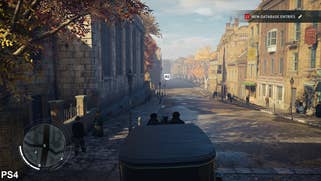
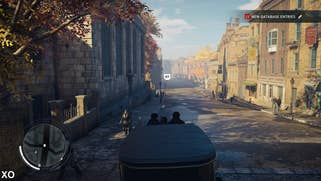
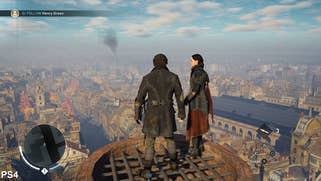
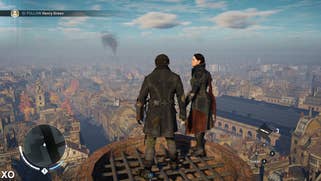
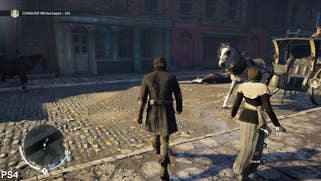
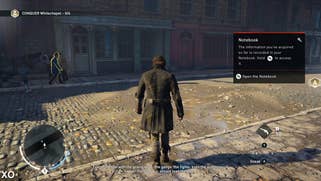
One thing that hasn't changed from Unity is the nigh-on identical lock in terms of visual features. We're still looking closely at both console versions of the game, but initial impressions suggest that once again the AnvilNext engine is offering an entirely like-for-like visual experience on both systems from the 900p resolution to the effects work, anti-aliasing and texture filtering settings.
In terms of stability, Ubisoft has also upped its game in terms of Syndicate QA and as a result, the multitude of glitches, bugs and overall strangeness we saw in Unity is substantially reduced. This is not to suggest that you're in for an entirely clean run though - in one area, we clipped through some scenery and got stuck in the water, necessitating a checkpoint restart. Elsewhere, characters disappeared in a cut-scene - an unwelcome oddity, but hardly game-breaking. Eurogamer's ACS reviewer Tom Phillips, and video editor Ian Higton - both of whom have sunk more hours into this game than we have - also report a much more solid experience compared to Unity, with no serious issues reported by the reviewer and two hard resets back to the console front-end for Ian, both caused by nothing more than starting a mission. Not completely ideal then, but more along the lines of a standard Assassin's Creed title as opposed to last year's nightmare.
Overall, it feels like Syndicate is a very positive step in the right direction. Stability isn't perfect, but there's no longer the sense that bugs, glitches and oddities actively intrude on the gameplay experience. Meanwhile, performance isn't up to the rock-solid frame-rates achieved by Assassin's Creed 4: Black Flag, but it's certainly good enough - especially on PlayStation 4. And we are reaping the benefits of an engine designed for the current generation of console hardware, as opposed to the moderately enhanced last-gen technology we saw in Black Flag. Conceptually and technologically, perhaps the raw ambition of Unity is missing, but Ubisoft has doubled down on gameplay and stability. Combine that with perhaps the most iconic location seen in the series to date, and we'd suggest that given the brutal time-constraints in producing these titles, Ubisoft has done well here and it feels like the series is back on track.
Our guide to finding every music box in Assassin's Creed Syndicate is live now.










